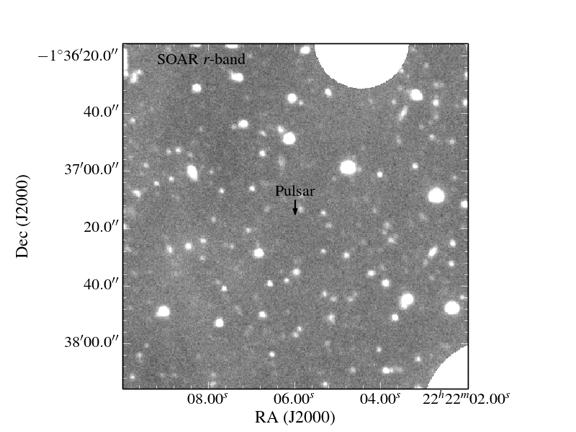Daily Image
29-07-2014Twinkle, twinkle, little star...
| Submitter: | Adam Deller |
| Description: | "...like a diamond in the sky". If you believe your nursery rhymes, then stars should twinkle like diamonds in the sky. Reality, however, has shown us quite the opposite: it is the absence of a visible star in this optical image that leads us to conclude that we found a diamond in the sky. Making this connection, however, required a big stack of data from a wide range of astronomical facilities. The point marked in the optical images is the location of the radio pulsar J2222-0137, discovered by the Green Bank Telescope in 2007. The pulsar is in a binary system, orbiting its companion every 2.45 days. Timing the arrival of the radio pulses can measure many orbital properties, including the fact that it is very circular, and the General Relativistic "Shapiro" delay which shows that its companion is slightly more massive than our Sun. The circular orbit makes it almost certain that the pulsar's companion is a white dwarf - the violent explosion necessary to form a second neutron star would have perturbed the system into an eccentric orbit. White dwarf stars are generally faint, but not invisible - and so we fully expected to see the companion when taking optical observations with the Keck and SOAR telescopes. However, as the figure above shows, nothing can be seen at the position of the pulsar! Astrometric measurements with the Very Long Baseline Array (see here) had already pinned down the distance to the system to better than 1%, so the dimness is not a result of the star being very distant. The only remaining explanation is that the system is nearly as old as the Milky Way galaxy, and the white dwarf is now very, very cold. So cold, in fact, that the carbon which makes up the bulk of the white dwarf would have crystallised and formed a colossal diamond - possibly 1000 times heavier than the famous diamond planet! These results were recently reported in the Astrophysical Journal (Kaplan et al., 2014, 789, 119). In the near future, approved observations with the Hubble Space Telescope should finally get a glimpse of the biggest diamond known in the sky. |
| Copyright: | David Kaplan et al. |
| Tweet |  |
